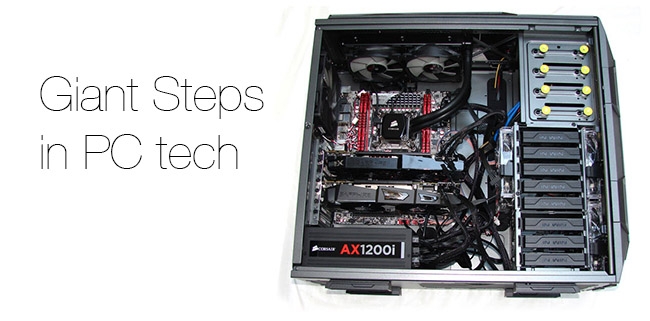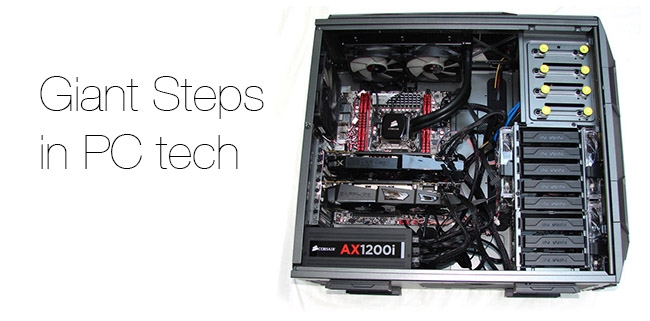
 How fast is your PC?
How fast is your PC?
Clock speeds may have been static for a decade, but everything else about PCs is changing. Neil Roberts describes the latest tech.
The humble PC has gone through a quiet renaissance recently. Up until a couple of years ago the focus of PC builders was the clock speed of the processor or CPU, with speeds gradually climbing to 3Ghz and above. The focus then shifted to multi-processor configurations, with 2, 4, 6 or even 8 cores per processor to handle the processing required. Power consumption has also been a priority for developers, especially for mobile applications.
Memory
Memory speeds have increased, moving from DDR to DDR2 and then DDR3, with a doubling of transfer speeds each time. (DDR4 is already in development but it will probably be next year before we see any systems) DDR3 is capable of moving up to 24GB of data per second but uses less power than DDR2. The switch to 64 bit operating systems has also meant that computers can take advantage of more memory. 32bit operating systems like Windows XP could only use 3GB of RAM but now with 64 bit versions of Windows 7 and Windows 8 (and Linux of course) the amount of RAM that can be addressed is far higher, up to 192GB in Windows.
Hard drives
Hard drives have increased in size and speed with typical SATA3 drives now capable of transferring 6Gbits of data per second but even this is being overshadowed by Solid state drives (SSD's) which can match the transfer speeds via SATA but have seemingly infinitely faster seek times as they have no moving parts. A hard drive can transfer sequential data from the platters at full speed but as soon as it has to go hunting for data the transfer speeds fall dramatically. Also there are SSD-based drives which bypass the SATA interface completely and connect directly to the PCI express bus (the system that connects all the components together) and can then transfer data at even faster speeds. Fusion-io have a card that can transfer data at 1.6GB/s. Meanwhile the cost of SSD's is continuing to fall.
Peripherals
Even peripherals can now be connected to the PC via USB3, with a data transfer rate of 5Gbits per second, or Thunderbolt which is slowly becoming available on PC's, with data transfer rates of 10Gbits per second. USB3 also has an advantage over USB2 in that it is bi-directional, allowing for reading and writing at the same time. Thunderbolt can connect many different types of devices such as capture cards and external storage but it also supports Mini Display Port and so can be used to connect external monitors.
GPU
One of the things that has always pushed development of PC hardware is gaming, with gamers seeking faster and faster performance from their machines, particularly with regard to the Graphics cards. Nvidia and AMD (formerly ATI) have been in a tug of war for the graphics performance crown over the last few years. Games have grown increasingly complex and graphically rich, with some of the latest games almost cinematically real. This has led to the development of graphics cards such as the Nvidia GTX600 series and AMD Radeon 7000s.
Although these cards were developed primarily for gamers more and more software is being written to take advantage of the processing power of these monsters. Graphical Processing Unit or GPU acceleration is now found in many applications for video editing, compositing and 3D animation, with many applications able to preview sequences in real time that would have been unthinkable a couple of years ago. The amount of memory on the graphics boards has also risen to 2, 4 or even 6GB which allows large data sets to be processed on the card. Nvidia also offers a graphics accelerator, the "Tesla" board, which can be combined with a high end Quadro graphics card to increase the processing capability of the system.
Graphics cards such as the Nvidia GTX Titan, which we covered here, blur the boundaries between professional workstation cards and gaming cards with very high GPU performance at a lower price than was previously possible.
PCI Express 3
The biggest change though has been with the PCI bus itself. There are now many new motherboards and chipsets that support PCI Express 3. This almost doubles the speed of PCI express 2, from 5bits/sec to 8Gbits/sec, and removes a major bottleneck in PC performance, allowing the transfer of data between the CPU, memory and storage to be far quicker.
Add all these advances together and you have a perfect storm of performance improvements.
The big PC manufacturers are offering workstations based around PCIe 3 motherboards, such as the Z620 and Z820 from HP and the Precision T7600 from Dell. These aren't cheap but they are built to perform flawlessly at very high speeds.
You can also get systems built by specialists to your exact specifications. Scan.co.uk do a range of computers specifically aimed at 3D and Video professionals and there are PC specialists like them in most regions of the world.
If you are feeling brave you could build your own system but when you are trying to push the envelope of performance it is often difficult to get the combination of components exactly right, and you have to be your own tech support!
Tags: Technology



Comments